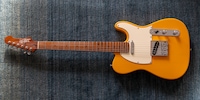

Junk or gem? Testing the ultra-cheap Dimavery ST-312 guitar
The Dimavery ST-312 costs under 150 francs or euros, but it has flaws that could turn off beginners and maestros alike.
When I bought my first guitar in 1992, it cost 400 francs and was the cheapest in the store. Today that’d be 525 francs, adjusted for inflation. The Dimavery ST-312 costs less than a quarter of that. Electric guitars around 100 francs or euros aren’t uncommon these days.
Generally speaking, the quality of the cheapest guitars varies more than that of your more expensive ones, where a strict and careful final inspection’s always carried out. As a result, it’s possible that some of the points I’m praising or criticising here will be less pronounced in other specimens of the same guitar. I ordered the guitar just like every customer would, so I didn’t test a hand-picked, particularly good specimen.
First impressions: nice, but unpleasant
I ordered the white version ST-312, which is also available in black. The pickguard – the cover around the pickups – is slightly purple in colour, which you can’t see in the product pictures. It looks neat, and I like the bright neck too. The dark fretboard, made of rosewood according to the specifications, looks strangely scuffed, though. It’s significantly thicker than on standard guitars.
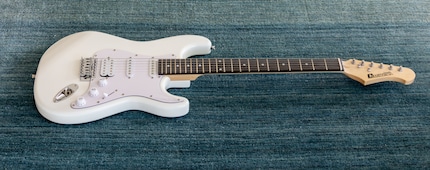
Source: David Lee
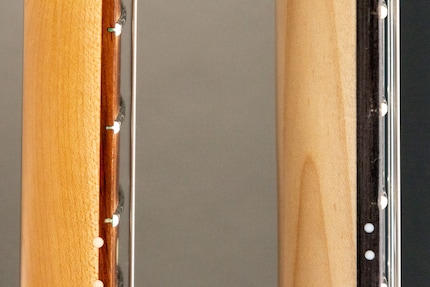
Source: David Lee
When tuning for the first time, the high E string breaks immediately. Not cool, but quickly fixed. What I find far worse is that I can feel the metal frets when I run my hand over the fretboard. They aren’t flush with the neck. Not nice at all.
The switch for changing pickups is unusually stiff. Pulling out a cable also requires more force than usual, and the guitar is constantly out of tune.
Setup and feel: not quite right
The pitch accuracy is more or less correct, but not exactly. I change that myself on the bridge, also adjusting the neck to be less curved so that the strings are closer to the frets. The tool for adjusting the guitar is included, as is a guitar cable.
The strings can be set quite close without buzzing, and the neck is also comfortable to play – apart from the fret problem. Nevertheless, I still can’t manage to play anything on the guitar without making mistakes. The strings are constantly out of tune. They’re mounted a bit strangely ex-factory, but I don’t think that’s the only reason.
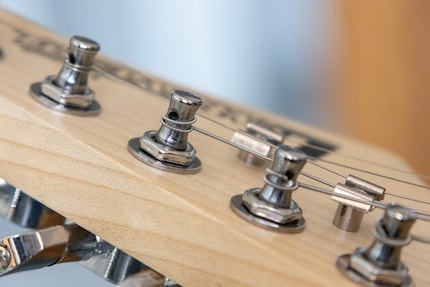
Source: David Lee
Sound: not quite balanced, but okay
The sound isn’t great, but okay. Ceramic pickups in HSS layout are installed – a humbucker at the bottom and two single coils at the top. This makes the guitar sound a little more powerful, but also a little duller than a typical Stratocaster. Switch positions 2 and 4, where two pickups are on, produce the typical Strat «quacking» sound loved by many – even if it isn’t particularly pronounced.
Here’s an example of the sound at position 2. All sound examples were played through a Roland Cube Lite practice amplifier, without effects, bass and treble in the middle.
The bridge position is much louder than the others. Since a humbucker pickup is installed there, this isn’t surprising. But it still bothers me. Switching to the loud bridge pickup is usually unpleasant, especially for higher notes. There’s no option to muffle the sound here, as the two tone controls only regulate the neck and middle pickups. This is also the case in the original Stratocaster, but I think it’s a design flaw that’s been fixed in many following models.
Noise: better shielding needed
Stratocaster-like guitars hum – that’s an essential trait, and not a negative one per se. It can only be heard well with distortion and only in certain switch positions. The Dimavery ST-312 also hums when only the neck or middle pickup is switched on. A normal Strat also hums when only the bridge pickup is active, the Dimavery ST-312 stays quiet here. But it does buzz when the bridge and middle pickup are switched on. Both have to do with the fact that a humbucker pickup is installed on the bridge instead of a single coil.
So far, so decent. What you can also see in the video: the guitar is significantly louder when I don’t touch the strings. In other words, the electricity isn’t grounded by my hand. This means that it isn’t particularly well shielded compared to a quality guitar. The comparison guitar used in the video is a Fender American Professional II.
The tremolo disaster
After about a week, the guitar finally stays in tune. More or less. It’s a lot more fun, and I can now play something without making mistakes.
However, there’s still the matter of the vibrato, or tremolo, as Fender calls it. Here’s a video explaining exactly what that is:
The vibrato lever is incredibly tight, both when turning and when pushing down the bridge. And when I use it, the guitar still goes out of tune immediately.
As is usual for this type of guitar, the tremolo block is attached to the body with three springs. What’s unusual is how tightly they’re wound. I take the middle one out for a test – maybe the problem can actually be solved that easily. Of course, the bar isn’t as tight, but the guitar’s even more out of tune.
And now I can’t even insert the removed spring any more. When I try to push it back in with a tool, I mess up the small hole. I also tear off a piece of skin. Alright, that’s it. This spring won’t go back on.
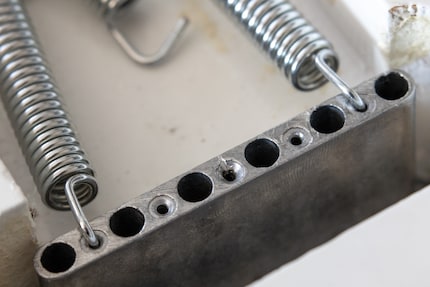
Source: David Lee
In a nutshell
More frustrating than fun
In view of its low price, the first thing I have to say is this – the Dimavery ST-312 is a real, functioning electric guitar. I can play it and it sounds okay. In any case, the one I’ve tried doesn’t convince me. Its protruding frets are clearly noticeable and annoying. The tremolo bar is also simply unusable. It’s best to fix it with a block of wood; the guitar will probably go out of tune less this way too. The strings on the guitar I tested were constantly flat for a week.
Even for less than 200 francs or euros, you can find better guitars. The Yamaha Pacifica 012, with the same pickup configuration, has had a very good reputation for many years. Unfortunately, we don’t have it in our shop. I’m also going to test the low-cost Jet 300.
Pro
- very affordable
- nice colour (white version)
- passable sound
Contra
- annoying protruding frets
- miserable tremolo system
- varies in pitch
- no tone control for the bridge pickup

My interest in IT and writing landed me in tech journalism early on (2000). I want to know how we can use technology without being used. Outside of the office, I’m a keen musician who makes up for lacking talent with excessive enthusiasm.
